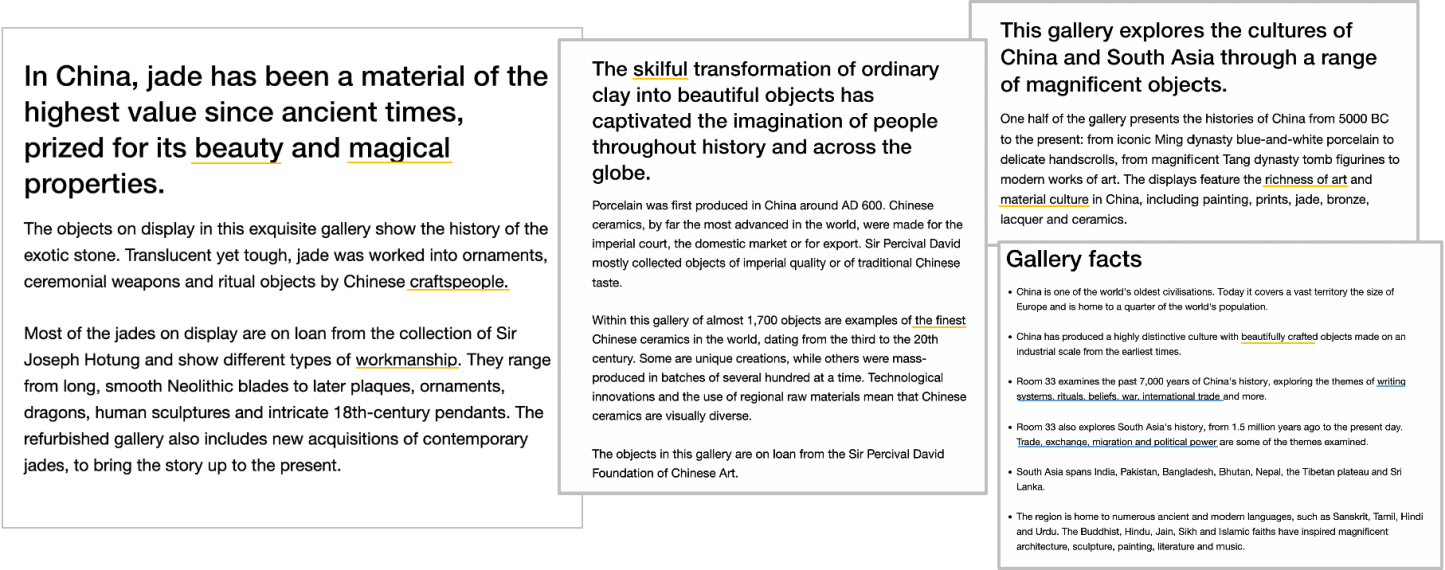

Volume 6
Published on September 2023Volume title: Proceedings of the International Conference on Social Psychology and Humanity Studies

Museums have never been neutral. Public museums and exhibitions that originated in colonial times are accused of passing on biases that feature Euro-centric interpretations of history. This paper investigates the nature of bias and the history of museums and their biases, and then focuses on the representation of China in the British Museum as an elaborate case study. The paper argues that from the British Museum’s virtual collections and public resources, the descriptive text and collection highlights in the China galleries reflect implicit and biased historical perspectives of China in the UK, exhibiting a contrast between the British appreciation of exotic Chinese art and contempt towards China’s social status arising from colonial trade. This paper provides a specific statement and analysis of western biases for colonial discussions and could contribute to decolonization actions taken in museums.

 View pdf
View pdf


Since society has growing demands on young people, the mental health of adolescents is very important in the current society. This article reviews the causes, gender differences, and effects of four psychological issues among adolescents including anxiety disorders, depression, social communication disorders, and Attention deficit hyperactivity disorder (ADHD). The study reveals that among adolescents, girls are more likely than boys to experience the three mental health issues of social disorders, depression, and anxiety, while boys are more likely to experience ADHD. Moreover, this paper analyzes three areas: family, school, and government to discuss the solution for improving these issues and the current situation. Therefore, after reviewing previous literature and summarizing their findings, this paper contributes to emphasizing that girls have more probabilities to suffer from mental health problems than boys, thereby calling for society to pay more attention and offer more help to girls. Future research can work on how to reduce these conditions and propose some applicable solutions.

 View pdf
View pdf


In the paper Dark Desires, Seiriol Morgan aims to argue against the claim that “universal participant consent is sufficient for the moral permissibility of a sexual act” which is largely accepted in contemporary western philosophy. This article examines Morgan's argument against such a claim and improves Morgan's two illustrative cases to better support his claim. It starts by clarifying the meanings of the terms "moral permissibility", "dark desires", and "consent" to make Morgan's argument easier to tackle with. Then, the strong and weak versions of Morgan's claim will be distinguished, and their plausibility will be examined. Finally, it concludes that (i) only the weak version succeeds, and (ii) Morgan succeeds in showing consent to be insufficient for the moral permissibility of any sexual act.

 View pdf
View pdf


Culture is a product of social groups, and art as a medium presents people’s ideas. It has become particularly important and necessary to study the integration of culture into art, that is, how art presents a certain culture to understand society. This paper selects the post-World War II society and the resulting post-war culture. The paper discusses existentialism and feminism in post-war culture by examining the portrayal of the female character Bridget in the film noir The Maltese Falcon based on Sigmund Freud’s psychoanalytic personality theory. Summarizing the film and examining the existential femme fatale character Bridgette, the paper explores how the culture of postwar society influenced and reflected each other. The paper concludes that Bridgette, as a typical classic female character in a film noir, has an existential femme fatale personality that reflects the postwar culture that existed in society at that time. At the same time, cinema as an artistic medium interacts with and integrates with society.

 View pdf
View pdf


“Rose adolescents” are a group of people with different behaviors that differ from their biological gender identity. But few people in society pay attention to this group. This is inseparable from the role played by the media in communication and the education of sexual knowledge. Biased general cognition will harm this group physically and psychologically, leading to social problems, such as school bullying. They need to be understood by the public, and the physical and mental health of young people also need to be protected and given attention from multiple dimensions. So, the paper will use three theories related to gender, media, and diversity, analyzing public stereotypes of gender diversity and, the social impact behind it. How does the media play an essential role in guiding public comments? What can sex education do to help? In the end, the article believes that when mass media is widespread and biased in disseminating social information, the resulting erroneous or misleading information needs to be managed and guided by the press and the family, school, and society for the mental health of young people.

 View pdf
View pdf



Gender norms and gender exclusion in video games are worth discussing. Based on previous research on video games and gender equality, the article investigates how video gaming excludes female participation and becomes a male privilege. Understanding segregation is crucial because numerous video games today still feature misrepresentations of women despite the ongoing feminist movements that strive for equal rights. This article found that the video game industry was established by a male workforce that designed games to appeal to a male-centric market, thus the female voice is left out from the beginning. Women in contemporary video games are portrayed through the lens of male desire in which females are sexualized, powerless, and subordinate. They are excluded from the male-centric structure because of sexualization, sexual harassment, and workplace segregation. An optimistic vision of the future is also discussed due to the emergence of female voices in the gaming industry.

 View pdf
View pdf


The topic of this thesis is to study the performances of female characters in the TV series “Nothing But Thirty.” The goal is to see if they deconstruct and reimagine female characters' roles in Chinese film and television works. Today, with advances in mass media technology, feminism has become a public issue. In the wake of the #MeToo movement in 2017, there is an emerging trend in the portrayal of women in film and television. The visible presentation of the female image is inseparable from mainstream ideology. Given that “Nothing But Thirty” can be considered a female-dominated show, it would be interesting to examine the way women are represented on TV. This will help further promote the study of female representation in film and television.

 View pdf
View pdf


The emergence of the new media period has transformed social media into a public forum for the dissemination of public information, and the enhancement of user voice and demand has given feminism a new context and given women a free platform to express themselves. However, the ability of women to talk freely still faces significant restrictions as a result of the long-lasting effects of history and culture as well as the bias of the news media system. This essay attempts to explain the current situation of the absence of women’s voices on the platform by using Weibo, the dominant force of Chinese social platforms, as the research object. The research method of case analysis is used to broaden the analysis based on the facts and material already available. The research results emphasize the plight of women’s lack of voice in society, and put forward some relevant countermeasures from three different perspectives: media, women themselves, and social culture, to encourage the growth of women’s voice on social platforms and ultimately achieve gender equality.

 View pdf
View pdf



Furniture from the Ming dynasty is renowned for its distinct beauty and simplicity and is a priceless piece of Chinese history and culture. Additionally, the social and economic climate of the Ming Dynasty had a significant impact on the growth and prosperity of Ming furniture. The placement of furniture during the Ming Dynasty, however, not only emphasized the harmony of functionality and aesthetics but also expressed the thoughts and preferences of the Ming literati of the period. To highlight the distinctiveness of traditional Chinese furniture, this essay will first discuss the historical context of the development of furniture during the Ming Dynasty, then will particularly introduce a type of Ming furniture—Huanghuali furniture. The study will then analyze the simplicity, functionality, and indoor arrangement of Ming furniture to create a thorough introduction to Ming furniture and Chinese culture to let people better comprehend it.

 View pdf
View pdf


Guo Moruo is a modern Chinese writer, historian, archaeologist and statesman with many masterpieces. This paper mainly attempts to study and discuss the philosophical thoughts and inspirations of Guo Moruo and his anthology Goddess, which was created during the May Fourth Movement and embodied the spirit of the May Fourth Movement. This paper has profound literary and historical significance. By studying the personal feelings and the hidden historical background of Guo Moruo's anthology, readers can understand the historical significance and characters' stories at that time.

 View pdf
View pdf




